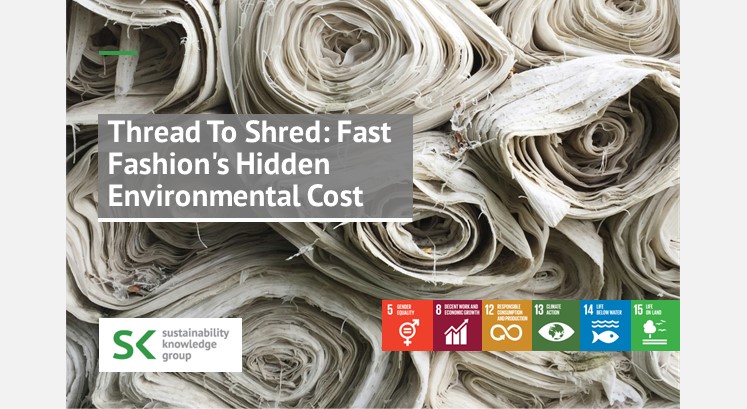In a world that never stops evolving, fashion trends change in the blink of an eye. The allure of a new wardrobe, the latest styles, and affordable price tags have made fast fashion a global phenomenon. However, beneath the surface of this seemingly glamorous industry lies a story that often goes untold – one of environmental degradation, labor exploitation, and unsustainable consumer practices.
In this blog, we delve deep into the realm of fast fashion, armed with compelling statistics that shed light on the actual cost of our clothing choices. While the allure of fast fashion is undeniable, it’s crucial to understand the numbers behind it. These statistics will reveal the impact on our planet and people and empower you to make more informed decisions as a conscious consumer.
According to the united Nation, the fashion sector has experienced a remarkable expansion in the early 21st century, currently boasting a valuation exceeding 2.5 trillion dollars and a global workforce of over 75 million individuals. From 2000 to 2014, clothing production doubled, and the average consumer now purchases 60 percent more garments compared to 15 years ago. However, the longevity of each clothing item has halved, signifying the fashion industry’s unmistakable transition into the era of “fast fashion.”
The Environmental Toll of Fast Fashion
The environmental impact of fast fashion is staggering. This industry contributes to the depletion of non-renewable resources, emits significant greenhouse gases, and consumes massive amounts of water and energy. It’s the second-largest consumer of water globally, with a single cotton shirt requiring 700 gallons and a pair of jeans needing 2,000 gallons of water to produce. Textile dyeing, a critical component of fashion production, ranks as the second-largest water polluter.
Moreover, fast fashion relies heavily on synthetic fibers like polyester, nylon, and acrylic, which release microplastics into the ocean during laundering, contributing to water pollution. The overall energy-intensive production process of textiles, including the use of petroleum, further adds to the industry’s environmental footprint. The use of pesticides in cotton farming poses health risks to farmers, while the leather production process involves toxic chemicals that contaminate water sources.
The Social Impacts of Fast Fashion
The social impacts of fast fashion are equally concerning. The majority of apparel production is carried out by young women aged 18 to 24, often in developing economies. Reports of forced and child labor in countries like Bangladesh, China, India, and others highlight the exploitative practices prevalent in the industry. Tragic incidents, such as the 2013 factory collapse in Bangladesh, where over a thousand workers lost their lives, underscore the human costs of fast fashion. The industry’s relentless pursuit of profits often takes precedence over worker welfare. Developing nations attract fashion production due to cheap labor, tax incentives, and lax regulations, leading to poor working conditions and environmental negligence. In essence, the social impact of fast fashion extends beyond exploitation to endangering the lives and well-being of those involved in the industry, particularly in the global South.
How Can You Reduce Your Fashion Footprint?
Eon asserts its status as the initial digitization platform linking products throughout their entire lifecycle, encompassing everything from their introduction to their renewal. Upcycles can promptly recognize a product through this platform, receive pricing recommendations, and obtain guidance on effective marketing strategies. Furthermore, the digital record encompasses fashion suggestions, including tips on how to style the product in combination with other items.
Moreover, to combat the environmental impact of fast fashion, individuals can make a difference by being mindful consumers. The fashion industry’s staggering waste, with a truckload of textiles discarded every second, is driven by impulsive purchases and trends. Choosing second-hand clothing, emphasizing vintage, handmade, and swapped pieces, reduces the water-intensive production of new garments and promotes uniqueness. Investing in higher-quality, durable clothing and maintaining them extends their lifespan, benefiting the environment and workers. Finally, giving clothes a second life through repair, upcycling, sharing, or donating contributes to countering climate change, considering the industry’s looming carbon budget crisis by 2050.
Furthermore, a straightforward yet impactful approach to combat the environmental impact of fast fashion is to buy less. Research by Leeds University and Arup suggests that limiting new clothing purchases to just eight items per year could lead to a remarkable 37% reduction in fashion-related emissions, particularly in major urban centers worldwide. However, this practical solution comes with financial challenges for manufacturers and retailers, highlighting a common tension not unique to the fashion industry. Balancing sustainable practices with economic viability is a critical consideration as we strive to redefine our consumption patterns for a more environmentally responsible future.
The Role of SDGs in Transforming Fast Fashion
The Role of SDGs in Transforming Fast Fashion illuminates the intersection of style and sustainability, underscoring the profound impact of United Nations Sustainable Development Goals (SDGs) in revolutionizing the fashion industry and taking in to consideration environmental, social and governance priorities.
Within this discourse, SDG 12, emphasizing responsible consumption and production, resonates profoundly, urging a shift from fast fashion’s throwaway culture to one of sustainability. SDG 13, focusing on climate action, confronts the industry’s staggering carbon footprint, necessitating eco-conscious alternatives. SDG 14, addressing life below water, underscores the importance of combatting microplastic pollution stemming from synthetic textiles. Simultaneously, SDG 15, safeguarding life on land, urges sustainable practices that reduce land pollution and resource depletion. SDG 8 champions decent work and economic growth, advocating for improved labor conditions within fashion’s supply chain, particularly for its predominantly female workforce (SDG 5). “Fashioning a Sustainable Future” spotlights how embracing these SDGs catalyzes a transformative shift towards ethical production, sustainable consumption, and a fashion industry where style and responsibility converge, forging a more sustainable and equitable future for all.
Embracing Sustainable Style for a Brighter Tomorrow
As we draw the curtain on our exploration of fast fashion’s intricate web, it’s evident that change is necessary and within our grasp. The allure of affordability and trendiness has seduced us for too long, but now, armed with knowledge and purpose, we can rewrite this narrative. The power to transform the fashion industry, one of the largest global contributors to environmental degradation and labor exploitation, lies in our choices. We become the architects of a more sustainable future aligned with ESG priorities, by favoring quality over quantity, embracing second-hand treasures, supporting ethical brands, and advocating for circularity.
Let us redefine style not as a fleeting obsession but as a timeless commitment to the planet, its people, and future generations. Fast fashion may have been the story of the past, but sustainable fashion is our future narrative. Together, we can make it a reality and proudly wear our values.
___
Sustainability Knowledge Group is a global Sustainability, ESG and CSR advisory firm dedicated in creating value through strategic advisory and training solutions, coaching and meetups. We work with organizations to develop, manage, and measure effective Sustainability strategies and programs, address social and environmental challenges, and bring tangible results, positive impact and create better businesses. If you want to learn more about our services, tools and methodologies, please visit: https://sustainabilityknowledgegroup.com/services/
As a CPD Standards Office and ILM Recognised Provider, Sustainability Knowledge Group offers certified training courses on Sustainability and ESG. To join our trainings and gain the skills and knowledge you need to lead in Sustainability, visit: https://sustainabilityknowledgegroup.com/training

